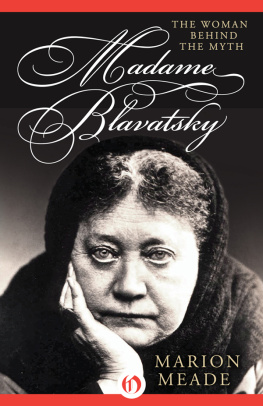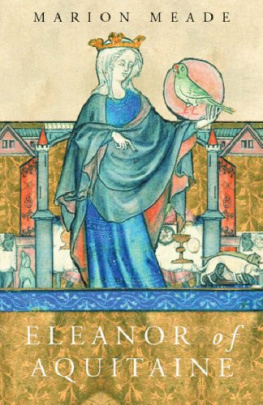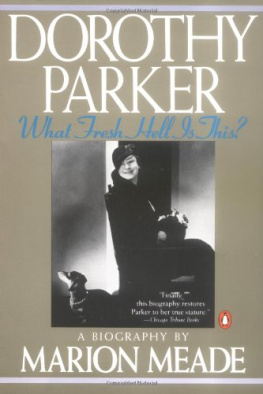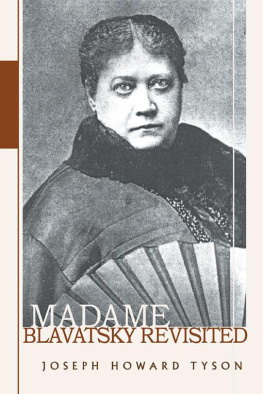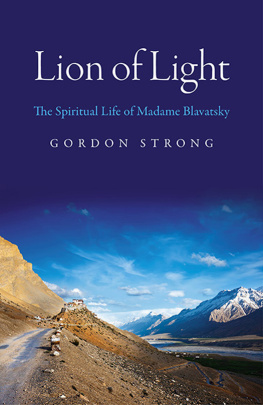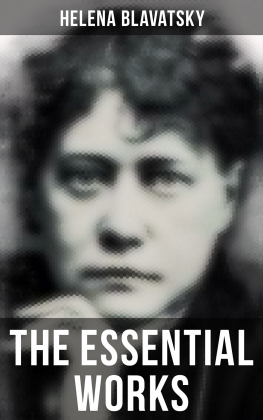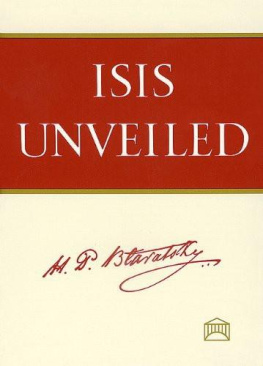Madame Blavatsky
The Woman Behind the Myth
Marion Meade

ACKNOWLEDGMENTS
This book would not have been written without the inspiration and encouragement of William Targ, who must be given credit for believing that H.P.B.s story deserved to be told one more time.
Many organizations assisted me in the gathering of information. Foremost I am indebted to theNew York Public Library for granting me the privilege of working in the Frederick Lewis Allen Room. I am also grateful for help given by staff members of the following libraries: the Butler Library of Columbia University; Monica Schulzetenberg of the Yale Divinity School Library; Kathleen Jacklin of the Cornell University libraries; the Olcott Library and Research Center of the Theosophical Society in America; the library of the New York Theosophical Society; Wayne Norman of the Eileen J. Garrett Library of the Parapsychology Foundation; the library of the Association for Research and Enlightenment; and the Department of Manuscripts of the British Library.
I am equally indebted to those individuals who have helped me in various ways: J. Gail Cayce of the Edgar Cayce Foundation, Dr. Gideon Panter, Martha Hollins, Jerome Rainville, Diane Matthews, Thetis Powers, Two Worlds Publishing Co. of London, Hanna Loewy, Mary E. Sidhu, Nancy Sommershield, Julie Coopersmith, Karen Dent, the staffs of Samuel Weisers Bookstore, and Quest Book Shop in New York City, and Norman Goodman, County Clerk of the New York County Court House.
FOREWORD
Helena Petrovna von Hahn Blavatsky led a mysterious life in exotic locales: Ekaterinoslav, Constantinople, Cairo. When she found her way to the United States in the steamy summer of 1873, without money or friends, she looked at the New World as the golden realm of opportunity shed been seeking.
Unconventional even as a child, Helena Petrovna was the high-strung granddaughter of a White Russian princess. In an age when women kept the home fires burning, she already was marching to her own drummer. She fled her grandiose family for a life of adventure, without regard for the consequences. It was predicted she would come to a bad end.
Turning up in New York, Helena at the ripe age of 42 looked frizzy-haired and dumpy. Aside from piercing azure-colored eyes she was not the least bit alluring but she had zing. The quick-witted newcomer lost no time. First, she got marrieda bad ideaand immediately got divorced. Then she steamrollered a married lawyer and Civil War veteran (Colonel Henry Steel Olcott) into being her acolyte, before turning her hand to writing and publishing. The book was Isis Unveiled, a complex study of science and theology seen in the light of ancient philosophy.
But most of all she became a celebrity by exploiting Spiritualism, the popular religious movement that believed the spirits of dead people can communicate with the living through mediums. New York has always had a taste for exhibitionistsP.T. Barnum, Boss William Tweed, the notorious Victoria Woodhull yet the rotund, chain-smoking Madame Blavatsky was one of the most novel. The press was soon covering her ghostly sances in which she, unashamedly, offered to link people with their dead relatives. By means of these advertisements for herself, the self-styled H.P.B. caught the publics attention. And meanwhile, she became the first Russian woman naturalized as an American citizen.
Together, she and the loyal Olcott founded an organization to promote her ideas. If one of the Theosophical Societys objectives was to investigate occult phenomena, a higher purpose was the study of eastern religions, using the wisdom of the ages to create a brotherhood of mankind. What she really wanted was to establish a new religion. Her New York sojourn ended when she moved on to India where she established the societys headquarters in Chennai (then Madras).
According to Helenas thesis, all things that ever were, that are, or that will be, [have] having their record upon the astral light, or tablet of the unseen universe, adding that the initiated adept, by using the vision of his own spirit, can know all that has been known or can be known. Craving for provocative ideas with intellectual grandeur, combined with Madames charismatic personality, helped explain the huge appeal of Theosophy to Victorians seeking enlightenment. Her promiseoffering nothing less impressive than the secret to life itself could not help but kick up very strong emotions.
During her lifetime, and afterward as well, a great many speculated that Blavatsky was simply a particularly clever snake oil salesman, hugely charming, with a large repertoire of marvels. True to form, she objected, emphatically. There is no miracle, she insisted. Everything that happens is the result of laweternal, immutable, ever active. Her admirers ranked her as a great intellect, a person of rare spiritual and psychic powers.
Truly one of a kind, Helena left behind a permanent legacy that she could not have foreseen. While dismissed as a female messiah, her efforts laid the groundwork for the New Age movement, which sought to reconcile Eastern traditions with Western occultism. Her teachings no doubt created new respect for the cultures and religions of the Eastfor Buddhism and Hinduismand interest in meditation, yoga, gurus, and reincarnation. Among the VIPs impressed by her message were, for instance, George Bernard Shaw, William Butler Yeats, and Mohandas Gandhi. In the 21st century, as the world continues to shrink and become increasingly a synthesis of East and West, Helena must definitely deserve some of the credit.
From the viewpoint of biography, Madame Blavatskys life journey must be viewed as uplifting. It is the story of a courageous young woman deeply in love with knowledge who struggled to use innate psychic abilities she did not understand. Blavatsky was middle aged when she embarked on her mission and only 59 when she died in 1891. Over that brief time she left her mark, heroic ideas that would inspire millions. The Theosophical Society, 135 years old, has branches worldwide today.
On the publication of this biography in 1980, I wrote that it was difficult to decide whether she was a great person or not, one that I liked or did not. Was she merely a lunatic of considerable charm? Which was more relevant: the woman or her work? Since then Ive sometimes asked myself, What was the point in writing about her? But I dont pretend to have an answer.
As any biographer will tell you, people are what they are. No more, no less. In Madame Blavatskys case, she was listening to music the rest of us cannot hear. Possibly some future generation can figure it out.
Marion Meade
January 2011
New York City
PREFACE
When Helena Petrovna Blavatsky was forty-five, she looked back on four-and-a-half turbulent decades and observed, One cannot remake ones past, one can only efface it according to ones strength. Actually she took pains to do both, and given her boundless energy, such efforts at revision were not entirely unsuccessful. For the last fifteen years of her life, she worked strenuously to re-create herself, erasing what she regretted having done, inserting new material, continually editing herself into the person she would have liked to have been. Thus at the age of fifty-four, in spite of two husbands, an indeterminate number of lovers and a child, she solemnly insisted she was a virgin.
Because she was an eccentric who abided by no rules except her own, she had excellent reasons for trying to conceal a history scandalously inappropriate for a religious teacher who wished to be taken as seriously as Jesus or Buddha. As the originator of modern Theosophy and cofounder of the Theosophical Society, she saw her mission as sublimely messianic: to save the world. Theosophy, literally interpreted from the Greek, means divine wisdom or knowledge of God, and, pre-Blavatsky, had been associated with the Christian Gnostics, Hebrew Cabalists and the teachings of Jakob Bohme and Paracelsus. Madame Blavatskys Theosophy was nothing less than an attempt to synthesize Brahmanism, Buddhism and Occultism into a new religion. It advocated a universal brotherhood of humankind and postulated the existence of Mahatmas or Masters, wise men of superhuman knowledge who lived in the Himalayas. It was her conviction that these men had trained her and then sent her out into the world with permission to disclose some of the secret knowledge that could light up a pitiless and incomprehensible universe.

